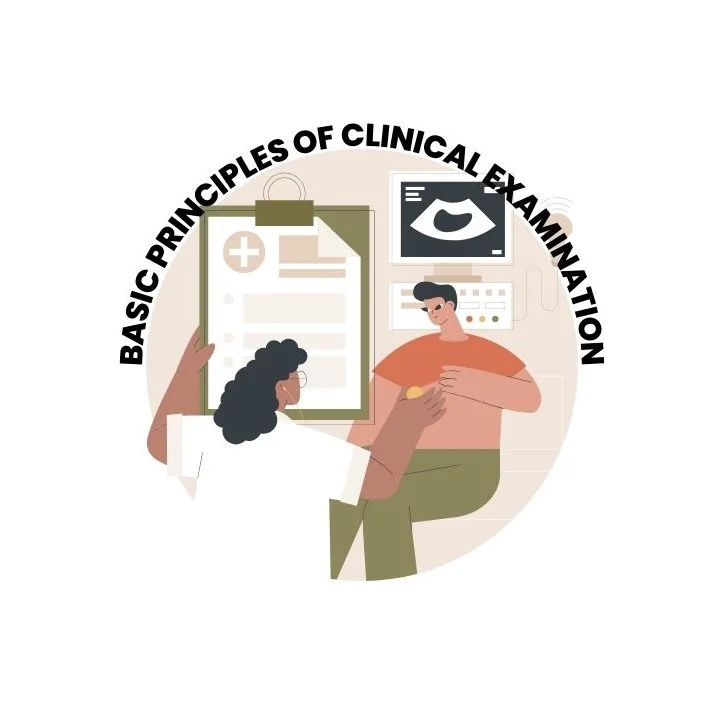Clinical examination is a fundamental aspect of healthcare where doctors assess patients to diagnose and monitor their conditions.
This guide breaks down the essential principles of clinical examination into easy-to-understand steps, making it an ideal resource for medical students and anyone interested in understanding the basics of patient assessment.
READ A DETAILED POST ON WHAT IS CLINICAL EXAMINATION? BY FOLLOWING THE LINK.

Table of Contents
ToggleSETTING THE STAGE: Creating the Right Environment
Place: The examination should take place in a warm, quiet, and private room. Privacy and comfort are essential for accurate observations.
Time: Preferably, examinations should be conducted in good daylight. Artificial lighting can introduce errors, so daylight is preferable, even if an examination is initially done under artificial light.
PATIENT COMFORT: Prioritizing Well-Being
Comforts of the Patient: Patients should be positioned comfortably during the examination. Uncomfortable positions should be avoided or deferred to the end of the examination.
EXAMINER'S POSITION: Getting It Right
Position of the Examiner: Typically, a right-handed examiner stands on the right side of the patient’s bed during the examination.
PREPARING THE PATIENT: Ensuring Proper Exposure
Removal of Clothing: Patients should be asked to loosen their clothing so that the areas to be examined are easily accessible. The surface being examined should be bare to ensure accurate observation.
Examination of Females: When examining female patients, it’s advisable for male doctors to do so in the presence of a female or a third party if the patient is comfortable with it.
READ WHY IS PATIENT COMFORT A PRIORITY DURING CLINICAL EXAMINATION? IN DETAIL BY FOLLOWING THE LINK.
CARE AND THOROUGHNESS: The Patient's Right
Care and Thoroughness: Carefully and thoroughly examine the patient. This is the patient’s right, whether they are paying for the examination or not. A rushed or incomplete examination can lead to harm or misdiagnosis.
OBSERVING CORRECTLY: The Power of Precision
Correct Observation: Always be doubly sure of your observations before reporting or recording any findings. Accuracy is crucial in clinical examination.
Correct Words: Use medical terms accurately. Precision in language ensures clear communication among healthcare professionals.
COMPARISON MATTERS: Right vs. Left
Comparison: Compare your observations between the right and left sides of the body. The two sides should be similar in many respects.
READ A DETAILED POST ON COMPARING OBSERVATIONS BETWEEN THE RIGHT AND LEFT SIDES OF THE BODY IN CLINICAL EXAMINATION BY FOLLOWING THE LINK.
AVOIDING "NORMAL": Describing Instead of Labelling
Avoid the Word ‘Normal’: Rather than simply labelling a finding as “normal,” describe the actual observation. This practice prevents oversimplification and encourages precise reporting.
READ WHY AVOIDING THE TERM ‘NORMAL’ IS ESSENTIAL IN CLINICAL EXAMINATION? IN DETAIL BY FOLLOWING THE LINK.
FAQs (Frequently Asked Questions)
Q1: What is the significance of the examiner’s position during clinical examination?
A1: The examiner’s position matters as it helps ensure a consistent approach. Typically, a right-handed examiner stands on the right side of the patient’s bed, allowing for easier access and observation.
Q2: How can I achieve precision in my clinical observations?
A2: Precision in clinical observation comes with practice and attention to detail. Always double-check your observations and use accurate medical terminology to ensure clear communication.
Q3: Why is it important to compare observations between the right and left sides of the body?
A3: Comparing observations helps identify variations or abnormalities more effectively. Similarities between both sides of the body provide valuable insights into a patient’s condition.
Q4: Why should medical professionals avoid labelling findings as ‘normal’ during clinical examination?
A4: Using the term ‘normal’ can oversimplify observations. Instead, describing the actual findings ensures accurate reporting and prevents misinterpretation.
Q5: What should I do if a patient feels uncomfortable during the examination?
A5: Patient comfort is crucial. If a patient feels uncomfortable, try to adjust their position or address their concerns. It’s essential to prioritize their well-being and build trust during the examination process.
CONCLUSION
Mastering the basics of clinical examination is vital for healthcare professionals.
By following these step-by-step principles, you can ensure a thorough and accurate assessment of your patients.
Remember, clinical examination is both an art and a science, and attention to detail and precision are key to success.













Leave a Reply